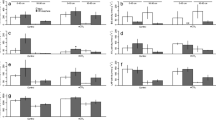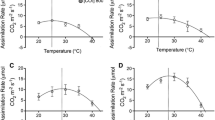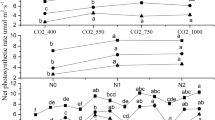Abstract
We measured CO2 efflux from intact root/rhizosphere systems of 155 day old loblolly (Pinus taeda L.) and ponderosa (Pinus ponderosa Dougl. ex Laws.) pine seedlings in order to study the effects of elevated atmospheric CO2 on the below-ground carbon balance of coniferous tree seedlings. Seedlings were grown in sterilized sand culture, watered daily with either 1, 3.5 or 7 mt M NH +4 , and maintained in an atmosphere of either 35 or 70 Pa CO2. Carbon dioxide efflux (μmol CO2 plant−1 s−1) from the root/rhizosphere system of both species significantly increased when seedlings were grown in elevated CO2, primarily due to large increases in root mass. Specific CO2 efflux (μmol CO2 g root−1 s−1) responded to CO2 only under conditions of adequate soil nitrogen availability (3.5 mt M). Under these conditions, CO2 efflux rates from loblolly pine increased 70% from 0.0089 to 0.0151 μmol g−1 s−1 with elevated CO2 while ponderosa pine responded with a 59% decrease, from 0.0187 to 0.0077 μmol g−1 s−1. Although below ground CO2 efflux from seedlings grown in either sub-optimal (1 mt M) or supra-optimal (7 mt M) nitrogen availability did not respond to CO2, there was a significant nitrogen treatment effect. Seedlings grown in supra-optimal soil nitrogen had significantly increased specific CO2 efflux rates, and significantly lower total biomass compared to either of the other two nitrogen treatments. These results indicate that carbon losses from the root/rhizosphere systems are responsive to environmental resource availability, that the magnitude and direction of these responses are species dependent, and may lead to significantly different effects on whole plant carbon balance of these two forest tree species.
Similar content being viewed by others
References
Aber J D, Nadelhoffer KJ, Steudler P and Melillo J M 1989 Nitrogen saturation in northern forest ecosystems. BioScience 39, 378- 386.
Amthor J S 1989 Respiration and crop productivity. Springer-Verlag, New York.
Amthor J S 1996 Plant respiratory responses to elevated CO2 partial pressure. InAdvances in Carbon Dioxide Effects Research. Eds. L H Allen, M B Kirkham, D M Olszyk and C Whitman. American Society of Agronomy, Madison, WI (In press).
Ap Rees T 1990 Carbon metabolism in mitochondria. InPlant Physiology, Biochemistry and Molecular Biology. Eds. D T Dennis and D H Turpin. pp 106-123. Longman Scientific and Technical, Essex.
Barta A L 1988 Response of field grown alfalfa to root waterlogging and shoot removal. I. Plant injury and carbohydrate and mineral content of roots. Agron. J. 80, 889-892.
BassiriRad H and Griffin K L 1996 Responses of loblolly and ponderosa pine to CO2 enrichment: Effects on growth, root respiration and NH4 + and NO3 -, absorption rate. Tree Physiol. (In press).
Bazzaz F A 1990 The response of natural ecosystems to the rising global CO2 levels. Annu. Rev. Ecol. Syst. 21, 167-196.
Boyer W D, Romancier R M and Ralston C W 1971 Root respiration rates of four tree species grown in the field. For. Sci. 17, 492-493.
Copeland L and Turner J F 1987 The regulation of glycolysis and the pentose phosphate pathway. InBiochemistry of Plants, Vol. 11. Biochemistry of Metabolism. Ed. D D Davies. pp 107-128. Academic Press, San Diego.
Diaz S, Grime J P and Harris J 1993 Evidence of a feedback mechanism limiting plant response to elevated carbon dioxide. Nature 364, 616-618.
Drew A P and Ledig F T 1981 Seasonal patterns of CO2 exchange in the shoot and root of loblolly pine seedlings. Bot. Gaz. 142, 200-205.
Dry I B, Bryce J H and Wiskich J T 1987 Regulation of mitochondrial respiration. InBiochemistry of Plants, Vol. 11. Biochemistry of Metabolism. Ed. D D Davies. pp 213-252. Academic Press, San Diego.
Edwards N T 1991 Root and soil respiration responses to ozone in Pinus taedaL. seedlings. New Phytol. 118, 315-321.
Eamus D and Jarvis P G 1989 The direct effects of increase in the global atmospheric CO2 concentration on natural and commercial temperate trees and forest. Adv. Ecol. Res. 19, 1-55.
Griffin K L, Winner W E and Strain B R 1995 Growth and dry matter partitioning in loblolly and ponderosa pine seedlings in response to carbon and nitrogen availability. New Phytol. 129, 547-556.
Griffin K L, Ball J T and Strain B R 1996a Direct and indirect effects of elevated CO2 on whole-shoot respiration in ponderosa pine seedlings. Tree Physiol. 16, 33-41.
Griffln K L, Winner W E and Strain B R 1996b Construction cost of loblolly and ponderosa pine leaves grown with varying carbon and nitrogen availability. Plant Cell Environ. 19, 729-738.
Hellmers H and Giles L J 1979 Carbon dioxide critique I. InControlled environment guidelines for plant research. Eds. T W Tibbits and T T Kozlowski. pp 229-234. Academic Press, NewYork.
Huang B and Johnson J W 1995 Root respiration and carbohydrate status of two wheat genotypes in response to hypoxia. Ann. Bot. 75, 427-432.
Johnson D, Geisinger D, Walker R, Newman J, Vose J, Elliot K and Ball T 1994 Soil pCO2, soil respiration, and root activity in CO2 fumigated and nitrogen-fertilized ponderosa pine. Plant Soil 165, 129-138.
Keeling C D, Bacastow R B, Carter A F, Piper S C, Whorf T P, Heimann M, Mook W G and Roelffzen H 1989 A three dimensional model of atmospheric CO2 transport based on observed winds. I. Analysis of observational data. Am. Geophys. Union Monogr. 55, 165-234.
K(ö)rner C and Arnone J A 1992 Responses to elevated carbon dioxide in artificial tropical ecosystems. Science 257, 1672-1675.
Lambers H 1987 Growth, respiration, exudation and symbiotic associations: the fate of carbon translocated to the roots. Soc. Exp. Biol. 30, 125-145.
Lambers H 1990 Oxidation of mitochondrial NADH and the synthesis of ATP. InPlant Physiology, Biochemistry and Molecular Biology. Eds. DT Dennis and D H Turpin. pp 124-143. Longman Scientific and Technical, Essex, UK.
Lambers H, van der Werf A and Konings H 1990 Respiratory patterns in roots in relation to their functioning. InPlant Roots: the hidden Half. Eds. Y Waisel, A Eshel and U Kafkafi. pp 229-264. Marcel Decker, New York.
Lewis J D, Thomas R B and Strain B R 1994 Effect of elevated CO2 on mycorrhizal colonization of loblolly pine (Pinus tadeaL.) seedlings. Plant Soil 165, 81-88.
Liljeroth E, van Veen J A and Miller H J 1990 Assimilate translocation to the rhizosphere of two wheat cultivars and subsequent utilization by microorganisms at two soil nitrogen levels. Soil Biol. Biochem. 22, 1015-1021.
Merckx R, Dijkstra A, den Hartog A and van Veen J A 1987 Production of root-derived material and associated microbial growth in soil of different nutrient levels. Biol. Fert. Soils 5, 126-132.
Møller I M and Palmer J M 1984 Regulation of the tricarboxylic acid cycle and organic acid metabolism. InThe Physiology and Biochemistry of Plant Respiration. Ed. J M Palmer. pp 105-122. Cambridge University Press, Cambridge, UK.
Norby R J, Gunderson C A, Wullschleger S D, O'Neil E G and McCracken M K 1992 Productivity and compensatory responses of yellow-poplar trees in elevated CO2. Nature 357, 322-324.
Norby R J 1994 Issues and perspectives for investigating root responses to elevated atmospheric carbon dioxide. Plant Soil 165, 9-20.
Oliver W W and Ryker R A 1990 Pinus ponderosaDougl. ex Laws. InSilvics of North America. Volume 1, Conifers Eds. R M Burns and B H Honkala. pp 413-424. Agriculture Handbook 654, United States Department of Agriculture, Forest Service,Washington, DC.
Padgett P E and Leonard R T 1993 Contamination of ammoniumbased nutrient solutions by nitrifying organisms and the conversion of ammonium to nitrate. Plant Physiol. 101, 141-146.
Palmer J M 1984 The operation and control of the respiratory chain. InThe Physiology and Biochemistry of Plant Respiration. Ed. J M Palmer. pp 123-140. Cambridge University Press, Cambridge.
Pregitzer K S, Zak D R, Curtis P S, Kubiske M E, Tern J A and Vogel C S 1995 Atmospheric CO2, soil nitrogen and turnover of fine roots. New Phytol. 129, 579-585.
Qi J, Marshall J D and Mattson K G 1994 High soil carbon dioxide concentrations inhibit root respiration of Douglas fir. New Phytol. 128, 435-442.
Reid C D and Strain B R 1994 Effects of CO2 enrichment on wholeplant carbon budget of seedlings of Fagus grandifoliaand Acer saccharumin low irradiance. Oecol. 98, 31-39.
Rogers H H, Runion G B and Krupa S V 1994 Plant responses to atmospheric CO2 enrichment with emphasis on roots and the rhizosphere. Environ Pollut. 83, 155-189.
Russell E W 1961 Soil Conditions and Plant Growth. Longmans, Green and Co., New York.
Ryan MG 1991 Effects of climate change on plant respiration. Ecol. Appl. 1, 157-167.
Schlesinger W H 1991 Biogeochemistry: An analysis of global change. Academic Press, New York.
Sokal R R and Rohlf F J 1981 Biometry, 2nd edn. W H Freeman and Company, New York.
Strain B R and Cure J 1985 Direct effects of increasing carbon dioxide on vegetation. Publication ER-0238, United States Department of Energy, Washington, DC.
Van de Geijn S C, Dijkstra P, van Kleef J, Groenwold K and Goudriaan J 1993 An experimental facility to study effects of CO2 enrichment on the daily and long-term carbon exchange of a crop/soil system. InDesign and Execution of Experiments of CO2 enrichment. Eds. E D Schulze and H A Mooney. pp 167- 174. Commission of the European Communities, Luxembourg.
Van Veen J A, Merckx R and van de Geijn S C 1989 Plant soil related controls of the flow of carbon form roots through the soil microbial biomass. Plant Soil 115, 179-188.
Van Veen J A, Lilgeroth E, Lekkerkerk L J A and van de Geijn S C 1991 Carbon fluxes in plant-soil systems at elevated atmospheric CO2 levels. Ecol. Appl. 1, 175-181.
Wahlenberg WG 1960 Loblolly pine: its use, ecology, regeneration, protection, growth, and management. Duke University, School of Forestry, Durham, NC.
Watson R T, Rodhe H, Oescheger H and Siegenthaler U 1990 Greenhouse gases and aerosols. InClimate Change: The IPCC Scientific Assessment. Eds. J T Houghton, G J Jenkins and J J Ephraums. pp 1-40. Cambridge University Press, Cambridge.
Zak D R, Pregitzer K S, Curtis P S, Terri J A, Fogel R and Randlett D L 1993 Elevated atmospheric CO2 and feedback between carbon and nitrogen cycles. Plant Soil 151, 105-117.
Author information
Authors and Affiliations
Rights and permissions
About this article
Cite this article
Griffin, K.L., Bashkin, M.A., Thomas, R.B. et al. Interactive effects of soil nitrogen and atmospheric carbon dioxide on root/rhizosphere carbon dioxide efflux from loblolly and ponderosa pine seedlings. Plant and Soil 190, 11–18 (1997). https://doi.org/10.1023/A:1004253232103
Issue Date:
DOI: https://doi.org/10.1023/A:1004253232103




